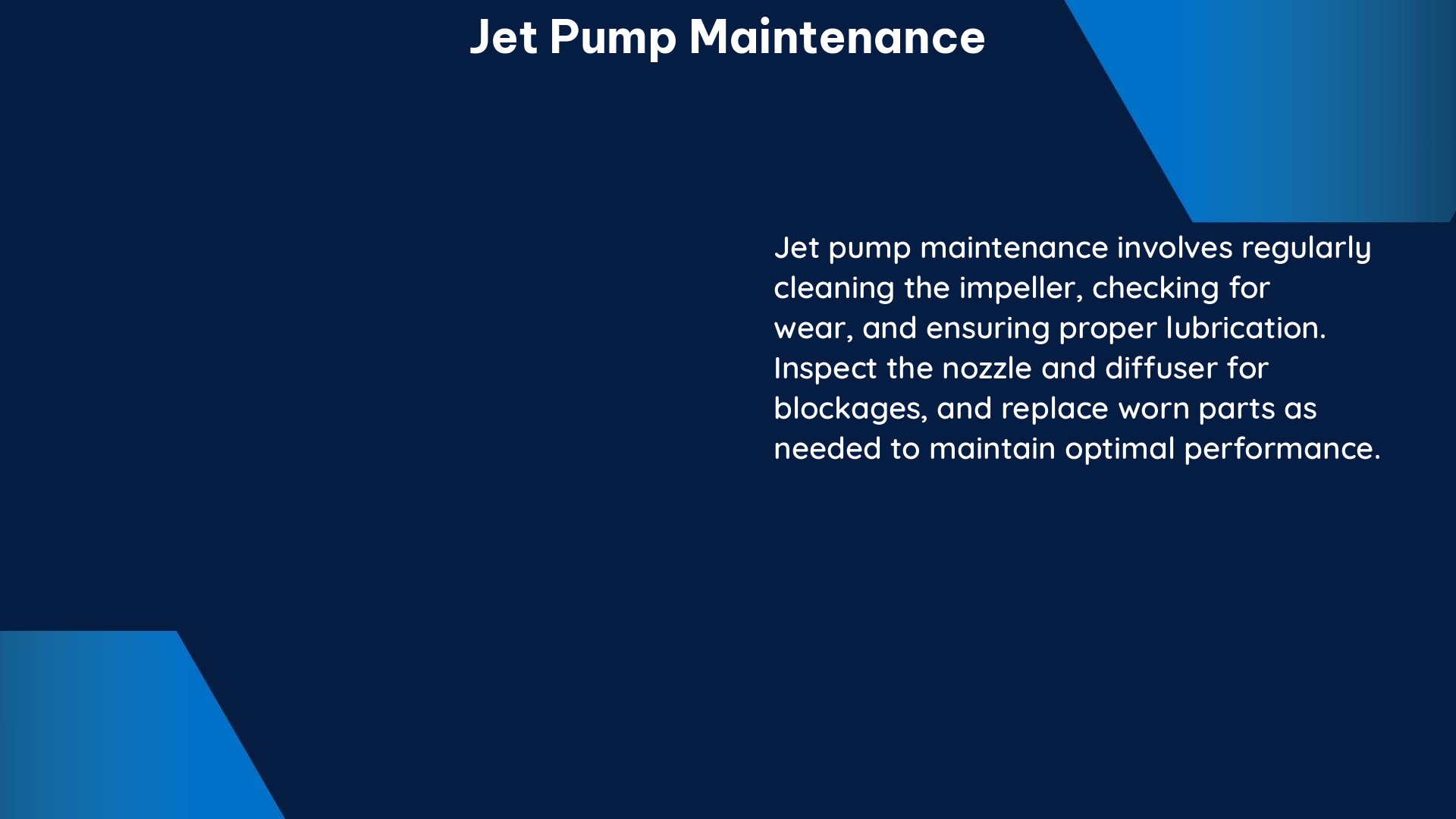Jet pump maintenance is a critical aspect of ensuring the efficient and reliable operation of hydraulic jet pump systems. This comprehensive guide delves into the quantifiable and measurable activities involved in maintaining jet pumps, providing you with the necessary knowledge and tools to optimize the performance of your system.
Routine Inspections and Cleaning
Regular inspections and cleaning of jet pump components are essential for maintaining optimal performance. Here’s a breakdown of the key steps:
-
Nozzle Inspection and Cleaning: Inspect the nozzle for any signs of wear, clogging, or damage. Clean the nozzle using a soft-bristled brush and a mild detergent solution, ensuring that all debris is removed. Measure the nozzle diameter and compare it to the manufacturer’s specifications to ensure it is within the acceptable range.
-
Diffuser Inspection and Cleaning: Examine the diffuser for any obstructions, wear, or damage. Clean the diffuser using a high-pressure water jet or a soft-bristled brush, taking care to remove any accumulated debris. Measure the diffuser’s dimensions and compare them to the manufacturer’s recommendations.
-
Impeller Inspection and Cleaning: Inspect the impeller for signs of wear, pitting, or imbalance. Clean the impeller using a soft-bristled brush and a mild detergent solution, ensuring that all debris is removed. Measure the impeller’s diameter and compare it to the manufacturer’s specifications to ensure it is within the acceptable range.
-
Suction Screen Inspection and Cleaning: Examine the suction screen for any blockages or damage. Clean the suction screen using a high-pressure water jet or a soft-bristled brush, removing any accumulated debris. Measure the screen’s mesh size and compare it to the manufacturer’s recommendations.
-
Seal and Bearing Inspection: Inspect the seals and bearings for any signs of wear or damage. Check the seal’s condition and replace it if necessary. Measure the bearing’s radial and axial clearances and compare them to the manufacturer’s specifications.
Preventive Maintenance and Repairs

Preventive maintenance and timely repairs are crucial for maintaining the long-term reliability and efficiency of your jet pump system. Consider the following activities:
-
Scheduled Maintenance: Develop a comprehensive maintenance schedule based on the manufacturer’s recommendations, operating conditions, and historical performance data. This schedule should include the frequency of inspections, cleaning, and component replacements.
-
Wear Part Replacement: Replace wear parts, such as nozzles, diffusers, and impellers, at the recommended intervals or when they fall outside the manufacturer’s specifications. Maintain a stock of critical spare parts to minimize downtime.
-
Vibration Analysis: Conduct regular vibration analysis to detect any imbalances or mechanical issues within the jet pump system. Use this data to identify potential problems and schedule necessary repairs or adjustments.
-
Performance Monitoring: Continuously monitor the jet pump’s performance by tracking key parameters, such as flow rate, pressure, power consumption, and efficiency. Use this data to identify any deviations from the expected performance and take corrective actions.
-
Troubleshooting and Diagnostics: Develop a systematic approach to troubleshooting and diagnosing any issues that arise in the jet pump system. Utilize advanced diagnostic tools, such as pressure and flow meters, to identify the root cause of the problem and implement the appropriate solution.
Real-Time Data Analysis and Optimization
Leveraging real-time data analysis can significantly enhance the performance and reliability of your jet pump system. Consider the following strategies:
-
Sensor Integration: Install a comprehensive network of sensors, including flow meters, pressure transducers, and vibration monitors, to capture real-time data from the jet pump system.
-
Data Acquisition and Storage: Implement a robust data acquisition and storage system to collect, store, and manage the real-time data from the jet pump system. Ensure that the data is complete, consistent, and free from noise and outliers.
-
Data Analysis and Optimization: Utilize advanced data analysis techniques, such as machine learning and predictive analytics, to identify patterns, trends, and anomalies in the jet pump system’s performance. Use this information to optimize the system’s operating parameters, such as flow rate, pressure, and power consumption, to achieve maximum efficiency and productivity.
-
Predictive Maintenance: Leverage real-time data analysis to develop predictive maintenance strategies, allowing you to anticipate and address potential issues before they lead to costly downtime or equipment failure.
-
Data Integration and Visualization: Integrate the real-time data from the jet pump system with other relevant data sources, such as production records and maintenance logs, to provide a comprehensive view of the system’s performance. Utilize data visualization tools to present the information in a clear and actionable format.
By following the best practices outlined in this comprehensive guide, you can ensure the optimal performance, reliability, and longevity of your jet pump system. Remember to always refer to the manufacturer’s recommendations and consult with qualified professionals for any complex maintenance or repair tasks.
References:
- Measurable Goals Guidance for Phase II Small MS4s: https://www3.epa.gov/npdes/pubs/measurablegoals.pdf
- How Do You Set Goals With Data?: https://www.evolvetogrow.com.au/resources/how-do-you-set-goals-with-data/
- Real-Time Data Analysis for Hydraulic Jet Pump Systems: https://www.linkedin.com/advice/3/how-can-real-time-data-analysis-optimize-hydraulic-mzp2c?trk=public_post_main-feed-card_feed-article-content
- Jet Pump Maintenance Best Practices: https://www.pumpsandsystems.com/jet-pump-maintenance-best-practices
- Jet Pump Performance Optimization: https://www.researchgate.net/publication/267800524_Jet_Pump_Performance_Optimization

The lambdageeks.com Core SME Team is a group of experienced subject matter experts from diverse scientific and technical fields including Physics, Chemistry, Technology,Electronics & Electrical Engineering, Automotive, Mechanical Engineering. Our team collaborates to create high-quality, well-researched articles on a wide range of science and technology topics for the lambdageeks.com website.
All Our Senior SME are having more than 7 Years of experience in the respective fields . They are either Working Industry Professionals or assocaited With different Universities. Refer Our Authors Page to get to know About our Core SMEs.